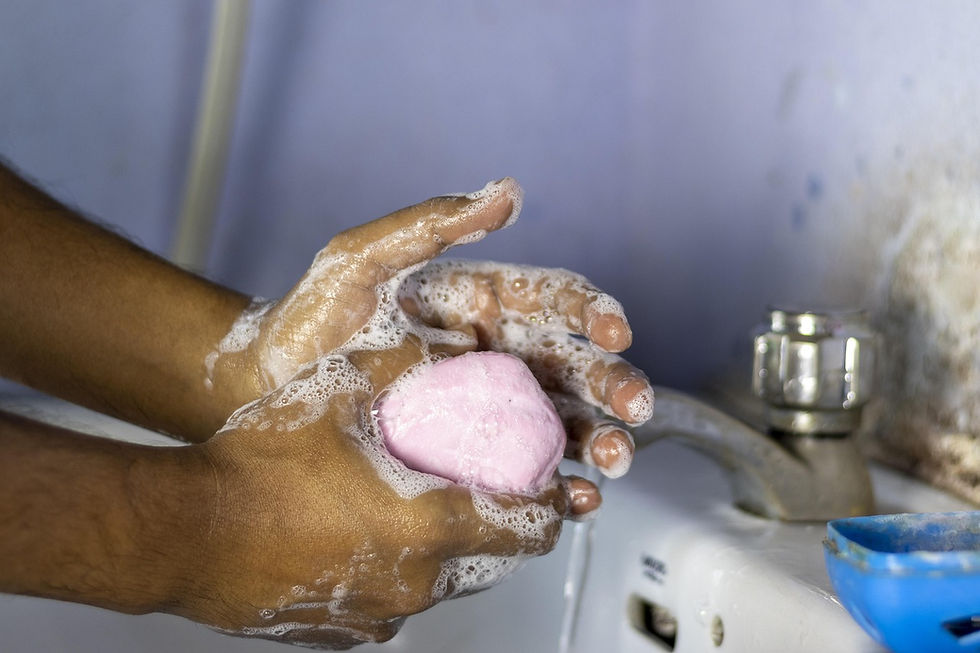The Unsung Heroes of Clean: Soap, Water, and Friction
- Aug 6
- 4 min read
Updated: Aug 11

Growing up is hard enough; nobody gives you a manual for the basics—like properly cleaning yourself and your environment. It’s a topic many of us assume everyone knows, but my experiences have taught me otherwise. From seeing the same washcloths used for toilet bowls and then doorknobs to witnessing an entire business office go a whole year without refilling their hand soap in the men’s bathroom, I’ve learned that the simple science of sanitation is often misunderstood.
I'm not here to shame anyone. I’m here to share the foundational principles of cleanliness so you can apply them to your hands, home, and health. Understanding these basics isn't just about looking neat; it's about staying healthy, preventing illness, and creating a comfortable, hygienic space for yourself and others. I'm here to share with you the unsung heroes of clean, which are simple: soap, water, and friction.
The Power of the Trio: Soap, Water, and Friction

The key to reducing germs and dirt isn't magic; it's a powerful combination of soap, water, and friction. Think of these three as your personal cleaning dream team, working together to eliminate the unseen enemies that can make you sick.
How it Works
Let's break down how this team operates. Soap molecules are unique because they have two ends—one that loves water and one that loves fat and oil. Imagine a tiny magnet with two different poles. When you apply soap and water, the fat-loving end of the soap molecule is drawn to and attaches to dirt, grease, and germs on your hands or any surface. These greasy particles often cling to surfaces, making them hard to remove with just water. But the soap acts like a tiny bridge. The water-loving end of the soap molecule then allows these dirt and germ particles, now attached to the soap, to be easily rinsed away with water. It's like the soap grabs onto the bad stuff and then makes it slippery enough for the water to carry it away.
The Role of Friction

Now, here's where the third hero, friction, comes in. Rubbing your hands together vigorously when washing them, scrubbing a surface with a cloth or sponge, or massaging your scalp with shampoo creates friction. This action isn't just for show; it's vital. Friction helps the soap molecules break up the dirt, grease, and germ clumps more effectively. It physically lifts the microbes and particles from the surface, allowing them to be surrounded and encapsulated by the soap. Think of it like loosening stubborn dirt before you try to sweep it away. Without this friction, the process is far less effective; the soap might loosen some grime, but it won't be able to grab onto and remove everything as thoroughly.
The Role of Rinsing

It seems simple, but my former roommate’s method of spraying cleaner without rinsing and leaving a sticky, dead-germ-and-grime lasagna on the floor and other surfaces proves that all three elements are necessary. Just as you wouldn’t leave soap on your body or shampoo in your hair, you shouldn't leave it on any other surface. The residue left behind can attract more dirt, feel sticky, and can even become a breeding ground for new germs.
Rinsing is the final, crucial step that removes all the bad stuff—the dirt, the germs, and the soap itself. A clean, wet cloth can pick up the residue, leaving you with a sparkling clean surface. You can rinse the cloth and repeat until no residue remains. This ensures that what you're left with is truly clean, not just covered in dead germs and leftover gunk. Wipe counters with your soapy dishcloth after washing the dishes, rinse and wipe again.
The Power of Three for Your Well-being

The Unsung Heroes of Clean: Soap, Water, and Friction
Understanding and applying the power of this trio—soap, water, and friction—is a fundamental skill for "practically adulting." It's not just about appearances; it's about genuinely reducing harmful bacteria and viruses around you, protecting your health, and creating a safer, cleaner environment for yourself and everyone you interact with.
The Centers for Disease Control and Prevention (CDC) and the Food and Drug Administration (FDA) both emphasize that handwashing with soap and water is a core pillar of public health. A study in the Journal of Environmental Health confirms that the mechanical action of rubbing and rinsing makes soap-and-water cleaning incredibly effective at reducing germs and grime.
So, next time you clean, remember your three unsung heroes and put them to work!
Your Practical Adulting Takaway
Knowing how to clean is a great first step, but putting it into practice is what truly makes a difference. Remember, the goal isn't to be perfect—it's to make your life a little easier.
Embrace the Journey to Habit: Building a new habit is like training for a marathon: the first few weeks are the hardest, and you do it more because you know it's good for you than because you want to. But with consistent effort, these actions become second nature. One day, you'll simply find yourself doing them without a thought, and you'll love the sense of calm that comes with it.
Make Maintenance Your Secret Weapon: Once a surface is truly clean, it's a hundred times easier to keep it that way. Get into the habit of a quick, daily reset. Spend just five to ten minutes at the end of the day putting things away, wiping down your food prep area, and washing your dishes. It's a small investment that pays huge dividends, saving you from a big, draining cleaning session later on.
----
Read More!
Curious about tackling those really tough messes? In our next article, "Beyond the Basics: Specialized Cleaners for Every Job," we'll dive into the world of cleaners designed for specific tasks, helping you conquer any cleanup challenge!
----
The articles in the Practically Adulting blog are written by a human named Luca and edited with the assistance of AI.




Comments